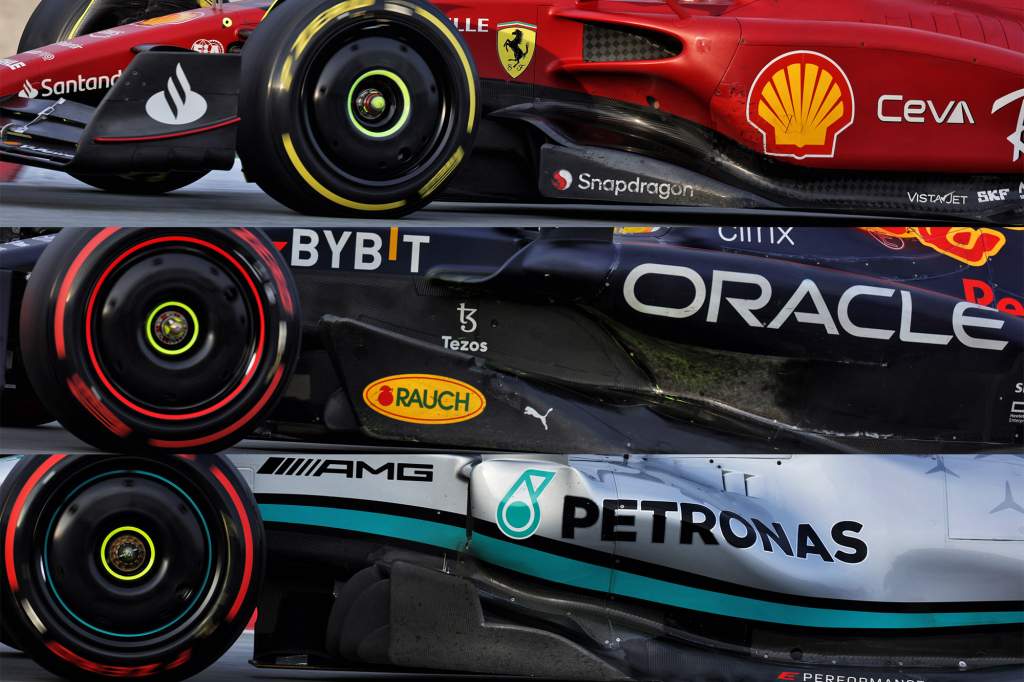Up Next

Given how prescriptive the 2022 Formula 1 regulations are, it’s a surprise to see the most visually-different crop of cars for many years.
It’s always difficult when a small group of engineers sits down to write the regulations then hands them out to the teams. At that point, hundreds, if not thousands, of engineers will scour them intensely to find the grey areas that might just give them that tenth of a second.
The sidepods have been the most visually different. Those differences, combined with the porpoising problem, might just go hand-in-hand. So I thought it would be worth taking a close look at each team’s solution.
Porpoising isn’t new. Any time you run an aerodynamic surface that is creating downforce near a stationary surface like the track, there is always potential for airflow separation. The harder you work that aerodynamic problem, the bigger the problem.
To explain this in more detail, this very rough graph shows the effect of airflow separation, or underfloor stall. The vertical access shows load, but it could be ride height change as they go hand in hand. When you lose load, the ride height will rise so the undulating trace in red on the graph could represent either.
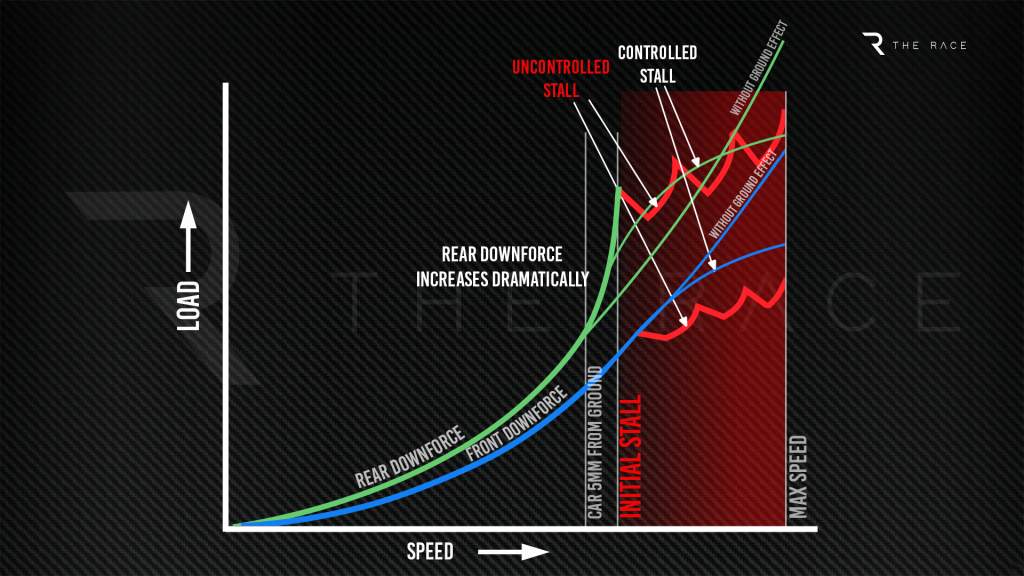
Normally, the downforce on a wing surface increases at the square of the speed – so twice the speed means four times the downforce. But with these cars, as the sides of the floor get closer to the ground that rate of change increases dramatically. This is what leads to the stall and, in turn, the porpoising.
Back when we last had ground effect cars with sliding skirts before they were banned, there was no change in the rate of downforce increase as the skirts were on the ground all the time, or if not they should have been. Actually, it was completely the opposite, if a skirt got stuck up, you had a dramatic loss of downforce.
Porpoising then was because you were asking far too much from the airflow traveling through the throat area of the underfloor, it just couldn’t could cope and would stall.
When you don’t have any airflow separation problems, the one thing you don’t ever want is for the downforce levels to increase as shown by the red lines. If it does that, this is what creates porpoising.
If you have airflow separation then it needs to be controlled, the downforce might not rise as quickly as it would if there were no separation problems. But provided you can keep that under control and understand the mechanism that is creating, this might allow you to use it as a tool to alter the balance of the car from low to high speed.
Normally, it’s the front of the car you want to be able to reduce the downforce on at high speed. Unfortunately, with these higher and less powerful front wings and the geometry of the underfloor, it is the rear that stalls so it’s difficult to do much with that to address the low speed understeer.
Reading through Doug Nye’s excellent book on McLaren is a reminder that this is an old problem. In the section about the ground-effect MP4 of 1981, John Watson commented that at Hockenheim it was the worst-handling car he had ever driven. He said the was so bad that his feet were thrown off the pedals and being smashed against the steering rack.
In those days, a large percentage of the underfloor downforce was on the front of the car. That’s why, at some races, teams didn’t run front wings so that the majority of the bouncing was at the front of the car. On some occasions, that led to the front wheels actually coming off the ground.
It’s not quite like that now as the underfloor loads are more equally distributed. But when it does start, it affects the rear of the car more than the front. This is because the teams have devised a method where the front corner of the underfloor is working slightly independently to the diffuser, which is mainly generating rear load.
Both will be affected, but if we classify what we see when the car starts bouncing as a 50% underfloor stall then that will have a 40% influence on the rear ride height and a 10% influence on the front ride height.
Some teams have it more than others and have gone about their design in different ways. As usual, I’m going to stick my neck out and put them in the order I believe is the best solution and why. And, of course, which is the worst.
But regardless of where teams are now with their sidepod designs, it doesn’t mean they cannot recover. Bodywork is bodywork, it only covers up what is underneath. If the bodywork is tightly-packaged, it means you can clothe it in something different without redesigning the complete cooling system. If it isn’t tightly-packaged then it could be that little bit more of a problem and will be more costly to fix.
There are two ways of getting, or at least attempting to get, the performance out of the underfloor.
One is what I call a mechanical seal. This is when the side of the floor actually touches the ground. This will only happen at high speeds as the downforce loads build up, pushing the car closer to the ground and therefore will potentially generate porpoising on the straights.
As the car will be higher when travelling slower in the corners, the porpoising problem will not be there, but neither will the grip. I would classify this problem as a light switch moment, it’s either on or off – in this case the track surface.
The other is what I call an aerodynamic seal. This is when the airflow coming off the detail of the front corner of the floor sets up vortices that help seal the rear part of the floor. If these vortices are strong enough, they will be there at all speeds so help through all the corner speed ranges.
If you get this to work consistently, it will mean you can run the rear ride height just that little bit higher and keep it away from that mechanical seal without losing too much overall downforce, if any. I call this a dimmer switch. It’s much more progressive, but it does mean you need to work that front corner of the floor to its maximum.
10 WILLIAMS
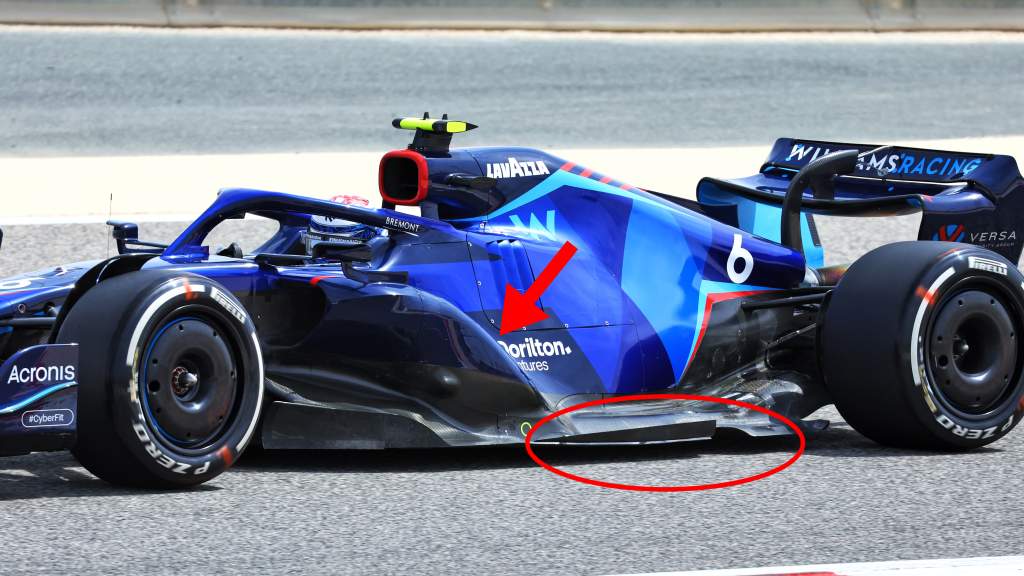
The tight packaging of the Williams is a bold move for a team trying to recover from some difficult years. I would have thought it might be better to go a more conventional route like Alpine, Alfa Romeo or AlphaTauri. Rome wasn’t built in a day, and it’s the same with Williams’s recovery steps. Trying to do it all at once can bite you.
The Williams design is very similar to the Mercedes but much more dramatic in how the sidepods drop away (red arrow). I don’t know how you can keep the airflow attached in this area and when it separates what happens to it. I’m sure Williams will have researched it and is confident it works, but I would still question it.
Williams has all the other gizmos like the outer edge slotted vane and the inlet to connect the end of this vane up to the high energy tyre squirt. So as far as that is concerned, it has all the tools in the tool box to make it all work.
It’s more a question of will that dramatic swept-down radiator housing allow it to get it all working together consistently.
9 MERCEDES
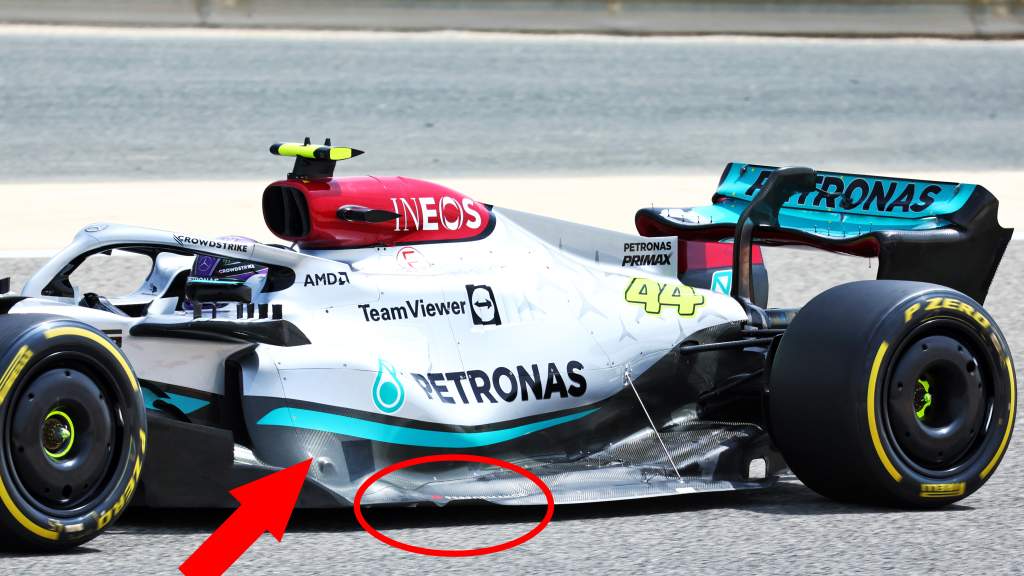
We can’t count Mercedes out of this championship yet, but it has along with Williams gone down its own path. The ‘zero sidepod’ design is certainly small with a vertical radiator inlet duct instead of the more common raised letterbox solution of most others.
None of this is a deal breaker, but I don’t see how Mercedes gets the required turning moment on the airflow coming off the leading edge of the floor (red arrow) to get any power behind the suction that it should create to pull airflow out from underneath the front corner of the floor.
Mercedes is still trying to achieve that, as can be seen by the small turned up section (red ellipse) on the outer edge of the floor, but then from there on rearwards the floor is fairly primitive. So Mercedes is relying a lot on the car’s ride height to seal the floor.
The light-switch effect of the floor being just off the ground and being on it is very difficult to control. Even the change of tyre pressures will affect it from lap one to lap five and beyond as the pressures build up.
Mercedes has even added a stay to support the rear corner of the floor, just to make sure it isn’t flexing too much which would open and close that gap to the ground. Mercedes is also running the car very stiff, so once again everything to let it get close to the ground but trying everything to stop it actually touching and setting off the dreaded porpoising.
It a nice package visually and the design is well executed and fairly different from all the others, but unfortunately that doesn’t mean it’s better or worse. Interestingly – but quite difficult to see – the sides of the sidepod are mechanically fixed to the floor and not just bonded there. Is this in preparation for another change? The car didn’t look great and every corner looked like a different experience for the driver.
Mercedes will be burning the midnight oil in Bahrain and Brackley trying to get the best out of it for the race weekend. But the first race might just come too soon for them.
8 ASTON MARTIN
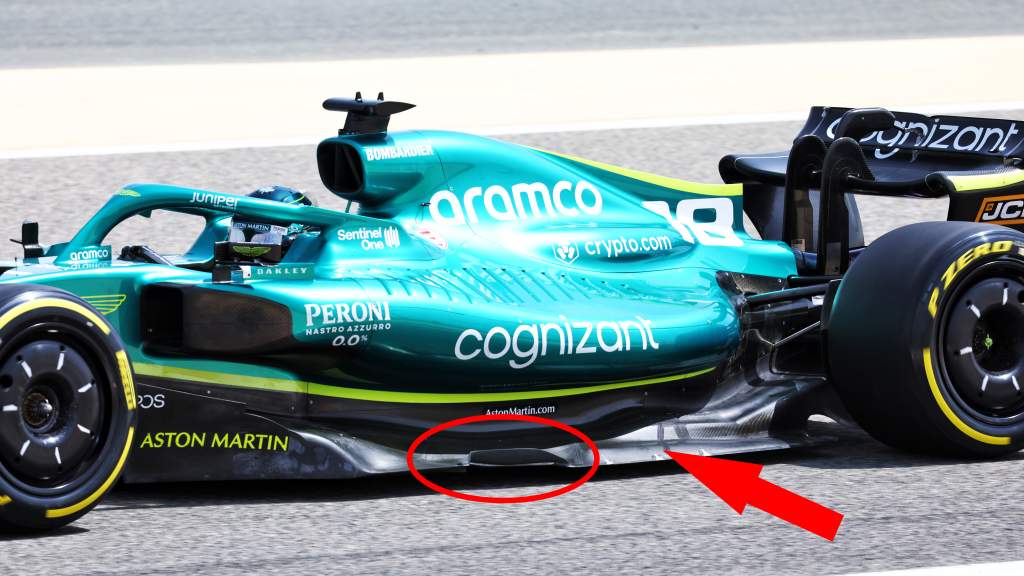
Aston Martin has gone for undercut sidepods. Initially, it was even likened to a double floor concept.
It has gone for the same philosophy as everyone else in that it has the turned up section on the outer edge of the floor (red ellipse). But with the leading edge undercut continuing all the way along the sidepod, I’m not sure there is an abrupt enough turning moment in the flow in this front area to work that front corner of the floor hard enough.
It does have a raised section in the foot of the floor (red arrow) but it seems to run out before it gets to where the tyre squirt would have an influence of the flow through this area.
It’s the polar opposite to what Ferrari has set about doing – and more on that shortly. Aston Martin has suffered with some porpoising but not the worst by any means. It has been pretty good over long runs and we haven’t really seen the team trying to set one-lap times. Therefore, this weekend will tell the tale.
7 HAAS
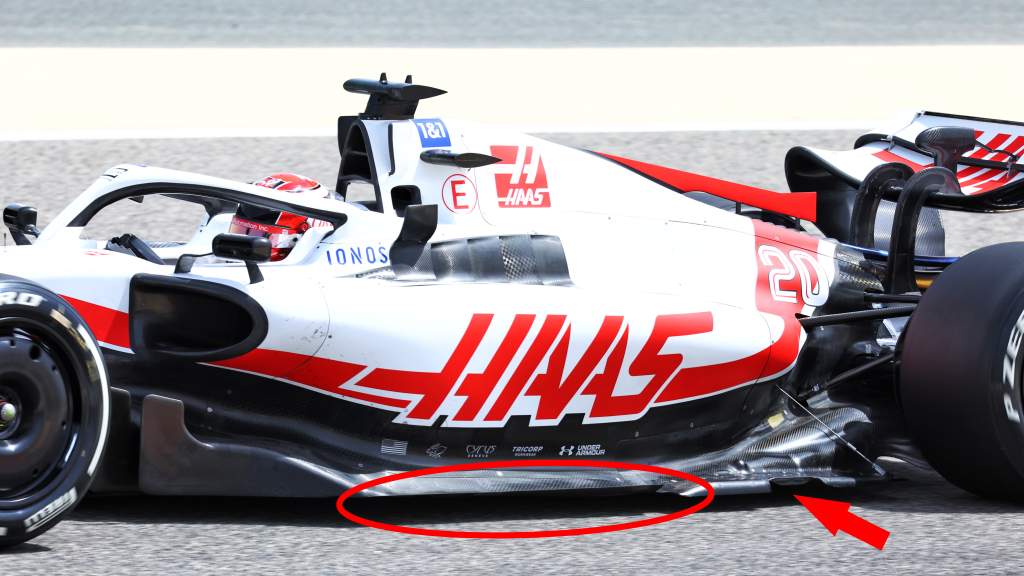
It’s not the same as the Ferrari, but you can definitely see it’s from the same family.
Haas has a long tapered front floor edge (red ellipse) allowing the airflow over the top of this section to scavenge as much flow as possible out of the front corner of the floor. Then there is the raised section (red arrow) connecting the end of this to the tyre squirt area. Haas also has a floor stay supporting the rear corner of the floor.
At Barcelona, the car looked pretty good and consistent. Haas didn’t set any spectacular time wise but other than a few reliability problems was pretty happy with the test.
In Bahrain, because of some shipping problems that delayed its start, it was able to run later in the day than the other teams. Because of this, comparing its performance to others is even more difficult.
6 FERRARI

When this car was released, I said I didn’t understand how the front and rear of the car aerodynamically was going to work together. I still stand by that but also suspect it is not so important now.
That’s because getting the most possible out of the front corner of the floor is one thing and then getting the rear section of the floor to not need to touch the ground is another.
Ferrari’s very bluff sidepod undercut (red arrow) area produces some outwash that helps the performance of the front corner of the underfloor. The small, curved outer edge (red ellipse) allows these vortices to generate.
Behind that, Ferrari has taken a leaf out of the McLaren solution and introduced this slotted gap horizontal turning vane and the small duct connection the end of this up to the tyre squirt area.
I still believe that both areas could work more powerfully if they were working more in conjunction with each other. But at this stage in the season it is OK. Later on when the developments start coming thick and fast, it might just be difficult for Ferrari to take the next step.
5 ALFA ROMEO
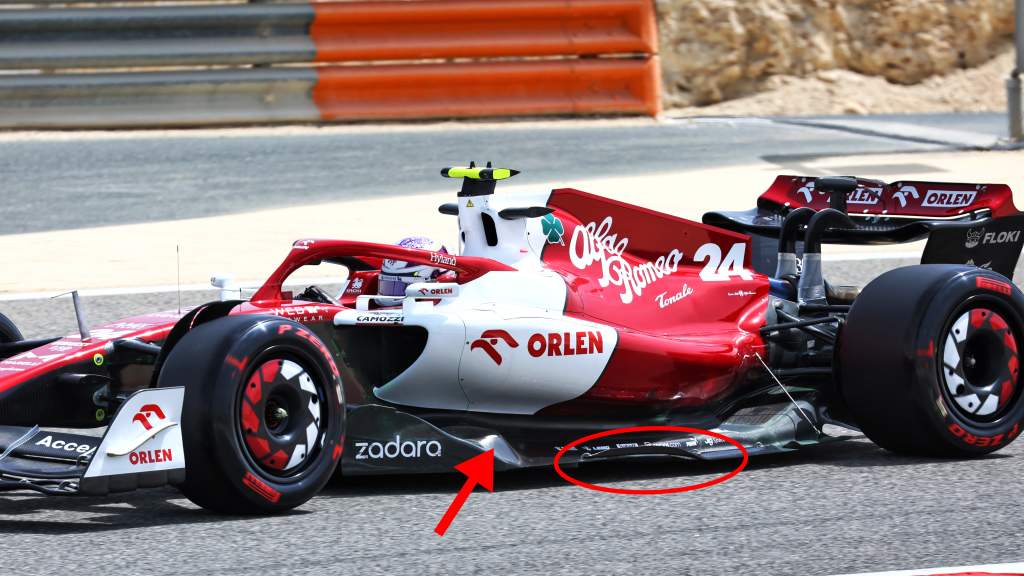
I’m not convinced Alfa Romeo had the chance to really show its real potential in testing. The car stopped early on the last day when it looked like it was just about to go for some performance runs.
Initially, it had huge porpoising problems but the team seemed to get on top of that fairly quickly. It has the slotted flap horizontal turning vane (red ellipse) and was actually the first to appear with it.
The floor-foot area behind this flap is very simple. There are no ducts, just a flat area so perhaps that could do with some attention.
Alfa Romeo also has a very pronounced trip (red arrow) where the lower side impact tube ends. This might even help trigger the vortices required to seal the rear of the floor and improve their intensity.
4 ALPINE

This middle group of teams in the ranking that concludes with Alpine are much of a muchness. Yes, they are all working the front section of the floor but are not doing much behind that to reduce the potential mechanical seal that leads to porpoising,
Alpine has raised the front corner slightly (red ellipse) and you can see the ends of the inner tunnel turning vanes. This works the area harder and helps with the robustness of the vortices.
But behind that, it a simple flat-foot area, which as already mentioned becomes a bit like a porpoising light switch – 5mm from the ground and it’s OK but touch the ground and it’s out of control. You can’t cope with that on a bumpy circuit.
3 ALPHATAURI
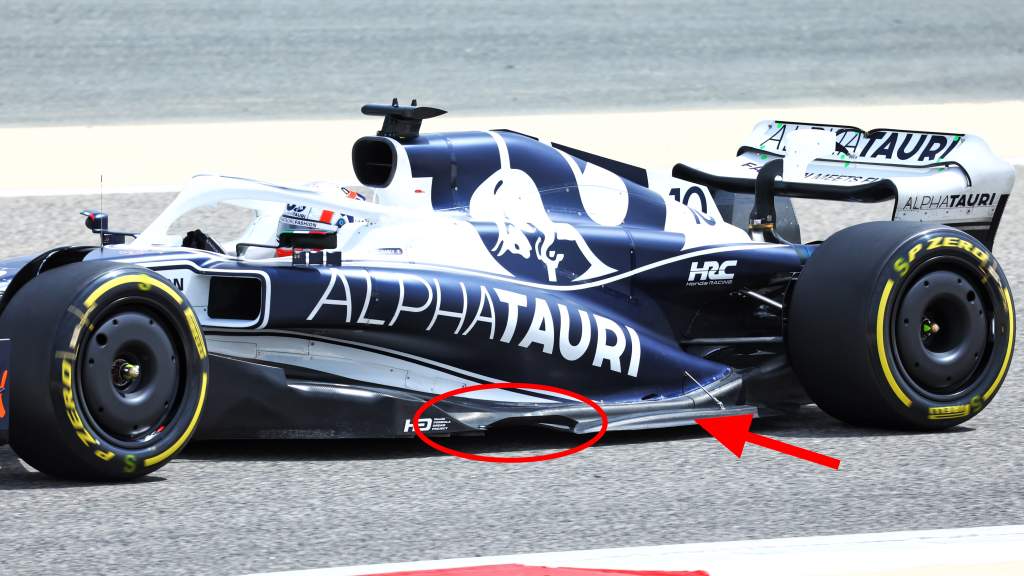
AlphaTauri’s sidepod package is very neat and tidy. Some might describe it as a bit too simple, but I would expect it to get more complicated very soon. In reality, airflow wants to do something simple. If you ask too much of it, it will simply say ‘enough is enough’ and give up – causing all sorts of problems.
AlphaTauri is also working the front corner of the floor as hard as possible. You can see the outer turning vane (red ellipse) with its small slot gap to allow the vortices to generate.
It doesn’t have as defined an inlet behind it, but you can see the tunnel effect (red arrow) in the floor footplate. Again, this will allow that tyre squirt to pull airflow through this area keeping the sides of the floor away from the ground.
AlphaTauri did have some porpoising problems, but seemed to be able to switch it off and on so apparently knows what’s causing it.
2 McLAREN
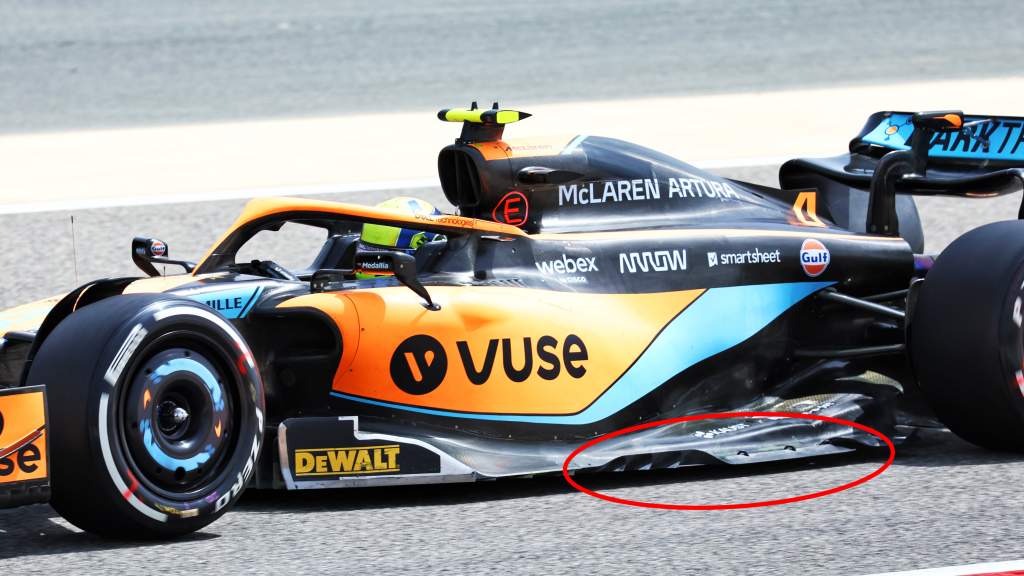
McLaren has been more or less on top of the porpoising problem since day one. Whether that’s by design or luck I’m not sure, but either way the car looks stable on track and appears reasonably well-balanced.
The detail on the outer edge of its floor is more dramatic than on the Red Bull. The turned-up section (red ellipse) and the small splitters in that area are all about scavenging airflow out from underneath that front corner and increasing the power of the vortices required to seal the floor further rearward. McLaren also has this small slot-gap horizontal wing section to maintain those vortices.
Then, at the rear of that red ellipse, it has an inlet to allow the tyre squirt to reduce the sensitivity of the flat foot area.
As with Red Bull, all this allow it to run slightly higher ride heights than some other cars but still keep the underfloor performance without having to use a mechanical seal.
1 RED BULL
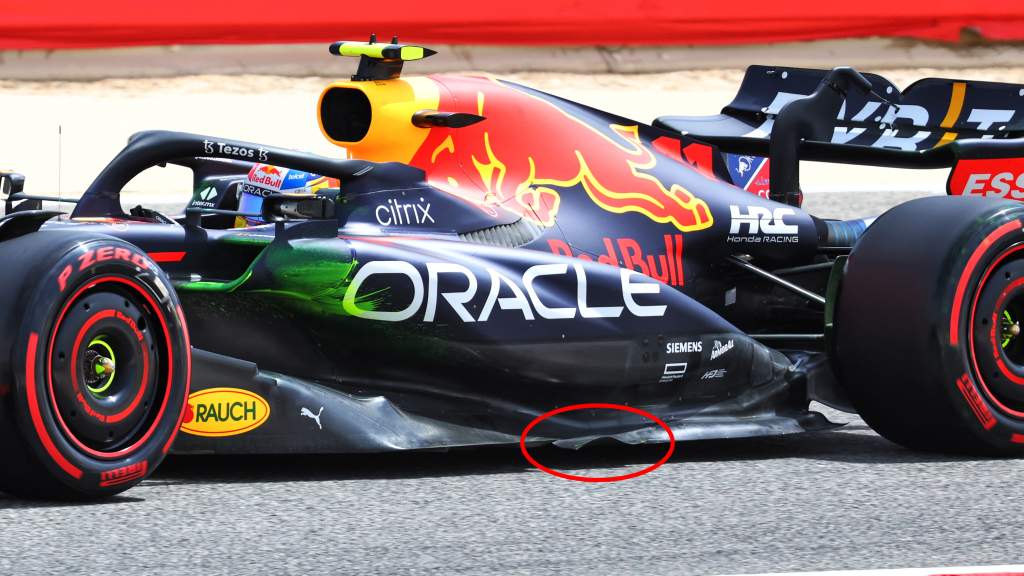
Given it is a product of the house of Adrian Newey, I have to place the Red Bull sidepods at top of the list. Newey is renowned for being able to ‘see’ airflow, which I’m not sure is right but he certain has a very deep understanding of how to get it all to work together.
Red Bull has focused its efforts on working the front corner of the floor as much as possible. This, together with the vortices going down the side of the floor, allows it to avoid the mechanical seal problem.
There is also a small duct (red ellipse) on the outside of the floor edge. I believe this connects up to a small tunnel in the floor’s outer foot. If so, the tyre squirt going around the inside of the rear tyre, which is very powerful, will be able to influence the flow in this area.
It’s all about sealing the floor without having to run the car so low that the mechanical seal sets off the porpoising.
By next Monday, we will have a slightly clearer picture of who needs to go off and get the jigsaw out and glue on some different parts and who has got it right.
But all of them can be modified to follow the direction of whatever looks like the right concept. It’s just that, sometimes, what works for one doesn’t work for all.


